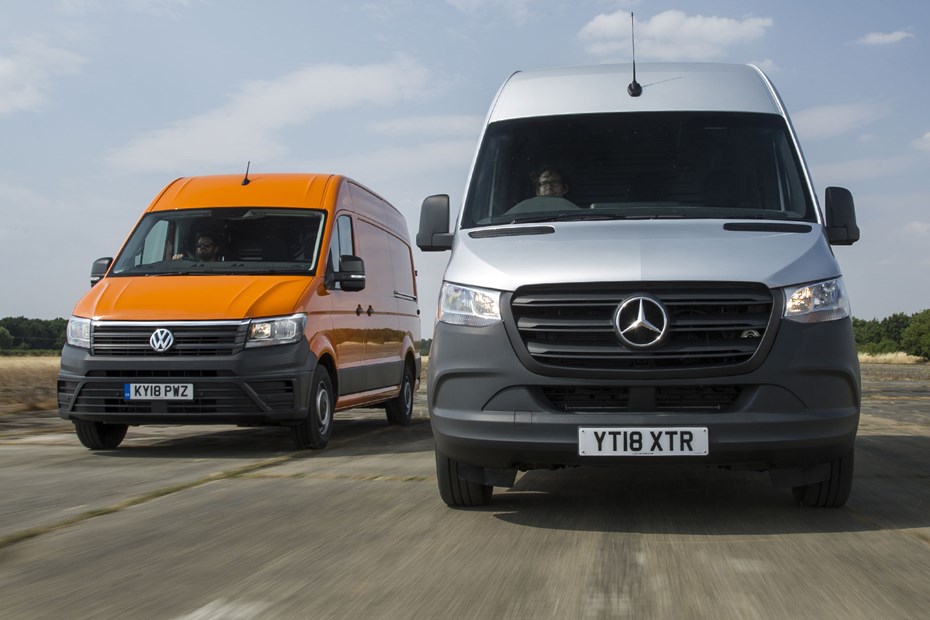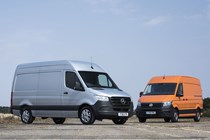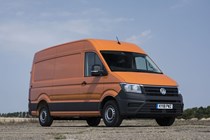Everyone likes a grudge match, right? The previous generation of Mercedes-Benz Sprinter and Volkswagen Crafter were different flavours of exactly the same large van, but for the latest models the two German brands have parted company and are now independently building direct rivals to each other. Here we’ve brought the two new vans together for the first time for a twin-test review to find out which is best.
Though the truth is that they are both very, very impressive – if perhaps for different reasons.
VW Crafter vs Mercedes Sprinter – the latest models
The VW Crafter launched the first strike. Going on sale in the UK in 2017 while Mercedes was still building the old Sprinter, the new Crafter appeared in somewhat piecemeal fashion initially, prioritising front-wheel drive (FWD) variants – as these were not previously offered – ahead of rear-wheel drive (RWD) and all-wheel drive (AWD), both of which are now available to order.
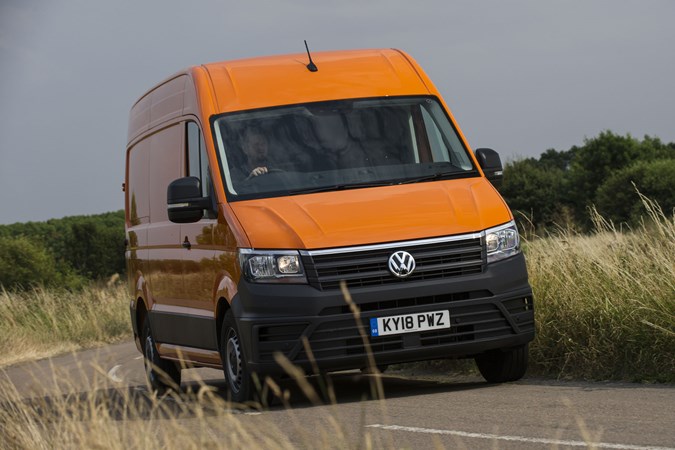
The Crafter immediately established its credentials as an exceptionally well thought-out large van, with a particularly intelligent cab design and remarkable ease of use – for something so big it is incredibly easy to drive – winning the inaugural Parkers Van of the Year Award as a result.
Driving one daily for six months as a long-term test left us in no doubt that it was a worthy winner.
The Sprinter is newer, with the first examples reaching the UK in mid-2018. More significantly, it’s been clear since the very first press events that Mercedes has been aiming not to simply build a successor to the previous model but to raise the ambitions of the entire van sector – by creating what is indisputably the most technologically advanced van we have ever seen.

What’s more, it is available with a front-wheel drive option for first time as well – matching all the other major rivals at last and, as with the FWD Crafter, freeing up some additional payload capacity and load space.
However, unlike VW, Mercedes has rear-wheel drive Sprinters available right from market launch. Since rear-wheel drive will remain important for the Sprinter’s heavy-duty operators (as RWD delivers better loaded traction), it’s an example of this we’ve got on test here. There is very little to choose between the driving experience of FWD and RWD variants anyway.
The Crafter we’re testing is front-wheel drive, to represent the most readily available examples of that model. It’s also fitted with its most powerful 177hp 2.0-litre TDI engine, while the Sprinter has a 143hp 2.1-litre engine – one of its more modest outputs.
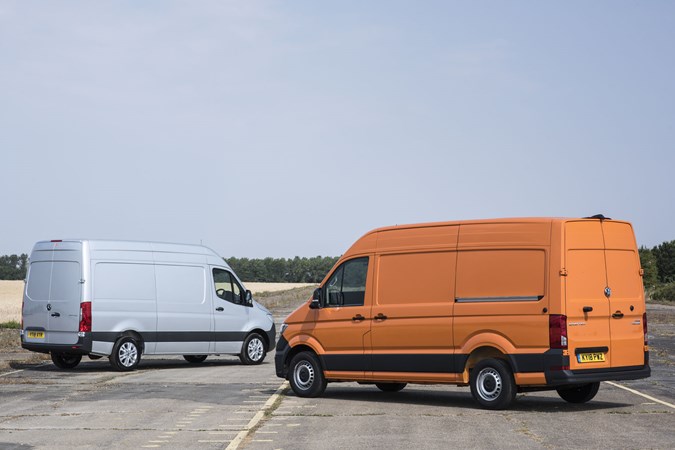
So, this isn’t an exact match-up. But the differences between these two examples of the breed matter less than you might think, especially in relation to the major advantages each van brings to this fight.
Working from the outside in, these are the areas we’ll be judging in order to decide which of these two vans is best:
Mercedes Sprinter vs VW Crafter – appearance
Does the way a van looks really matter? If it’s representing your business, the answer is surely yes – and especially at this end of the market.

The Mercedes image is tough to beat – few things project prestige better than a big three-pointed star. But the actual styling of the new Sprinter is perhaps a little soft and amorphous; while it echoes the minimalist lines of the current Mercedes car range, on a large van it comes across as rather… flabby.
Volkswagen might not be as posh as Merc, but it has a kind of up-and-coming eagerness about its image, which has long been considered classless. The Crafter is more crisply finished on the outside, too, with strong lines like a sharply pressed suit. It looks very smart and professional.
VW Crafter vs Mercedes Sprinter – cab interior
There’s a distinct contrast in styles in the cab of each of these vans as well – and since the cab is perhaps the most important area of the van for the driver, let’s take a closer look at what that means.
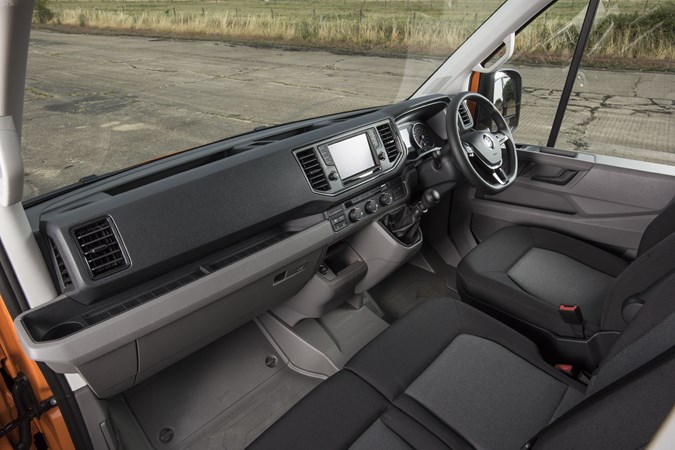
VW (above) has gone for functional clarity and maximum storage, with a practical design that’s directly inspired by discussion with working people during the Crafter’s development process.
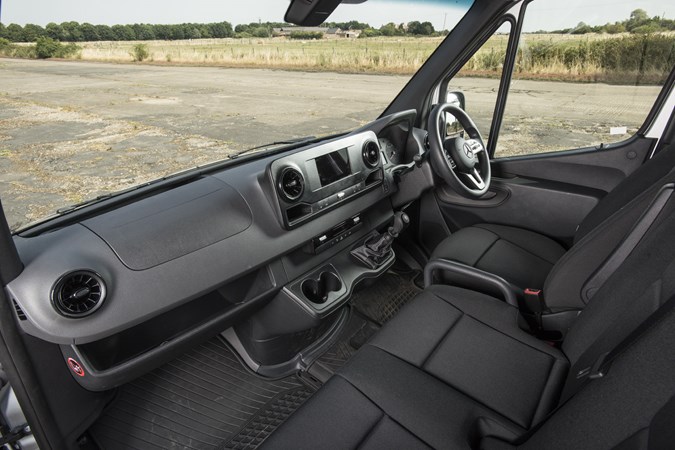
Mercedes (above), on the other hand, seems to have targeted wow factor. The very latest MBUX touchscreen infotainment system is fitted as standard (we’ll come back to this in more detail in the technology section below), the dashboard is swoopier and less van-like, plus several parts – such as the audio controls, air vents and indicator/wiper stalk – are directly shared with its passenger cars.
This is supposed to give the Sprinter a truly premium feel – Mercedes reckons this is showing respect for its customers – and at a glance it certainly looks good enough to impress any clients who end up in the passenger seat.
But we’ve driven several new Sprinters now, and if you compare the physical substance of the main dashboard plastics and the tightness of the fit and finish, it’s difficult not to conclude that the Crafter offers higher overall quality of build. And not just by a little bit.
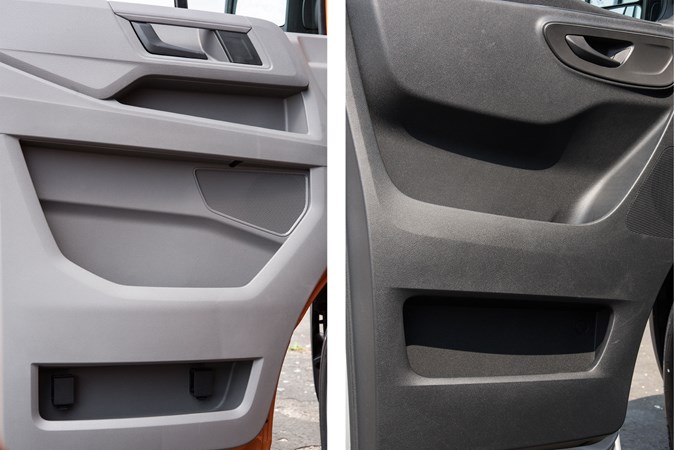
Pretty though the Mercedes is inside, we’re far more swayed by the substance and clear thinking that’s gone into the VW’s interior design. As a van its interior works much better for us. For example, the Crafter has three storage areas in the doors to the Sprinter’s two, and the shelf that runs across the entire width of the dashboard soon becomes strangely indispensable.
The Sprinter’s interior is more customisable, as you can choose to add or delete cubbies and cupholders as required, but there still seems to be fewer practical places to put stuff – and there’s not even the option of a proper glovebox (even the cubby hole pictured here is optional). The Crafter gets one as standard.
Mercedes does offer covers for the dashtop storage bins – the VW’s only really negative area, as items placed in the Crafter’s unlidded compartments are exposed to opportunistic thieves and reflect annoyingly in the windscreen when you’re driving – but these are only optional, and in our experience, tend to pop open distractingly as you’re going down the road.
Mercedes Sprinter vs VW Crafter – comfort
Both of these vans have excellent, highly-adjustable driving positions, which makes getting comfortable behind the wheel a doddle.
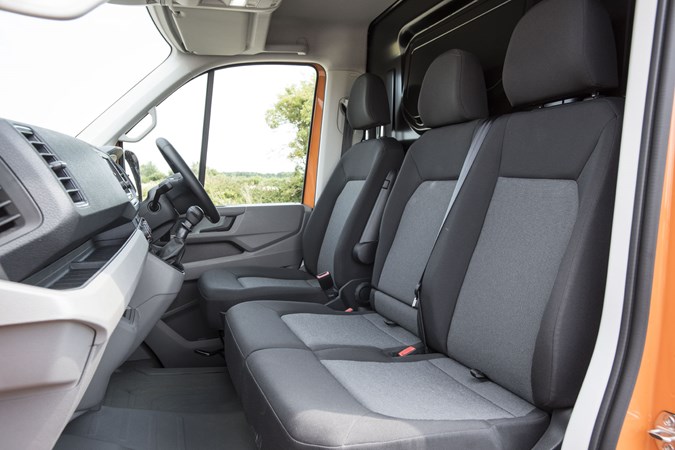
Both also have a choice of seat grades. In isolation we’ve always found the Crafter (above) to have very good seats – right up to the suspended seat at the top of the options list – but the Sprinter (below) is absolutely exceptional, with even more areas of adjustment available and really comfy contouring.
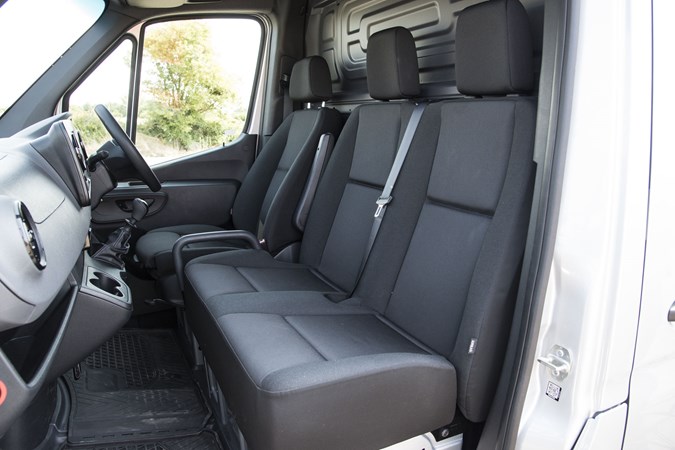
The Mercedes’ seats are unusually figure-hugging for a van, however. So if you are – how can we put this? – of a slightly larger build yourself, make sure you try them out thoroughly.
We found it easy to get in and out of the cab of both vans – multidrop drivers should have no complaints here.
In terms of noise and vibration, the Crafter has the edge – isolating its occupants from the engine to a greater extent.
Part of that comes down to this Sprinter being rear-wheel drive – and in our experience rear-wheel drive Crafters are considerably less refined than front-wheel drive examples like this one. But the VW’s 2.0-litre engine, which was new for this generation of Crafter, does seem to be quieter than the 2.1-litre motor Mercedes has been using for years and years.
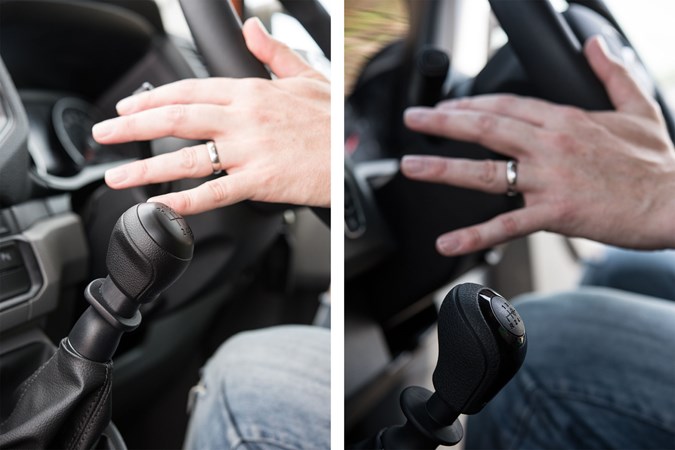
Also, the gearlever in the Crafter (left) is positioned noticeably closer to the steering wheel than the one in the Sprinter (right).
A small detail, but the difference struck us immediately and became unexpectedly jarring; having to reach that bit further every time is surprisingly wearing on longer journeys, making every gearshift more of an effort.
VW Crafter vs Mercedes Sprinter – driving experience
Interesting one this – and make no mistake, both of these rivals are exceptionally easy to handle for such large vans. The preferences here may well come down to personal priorities.
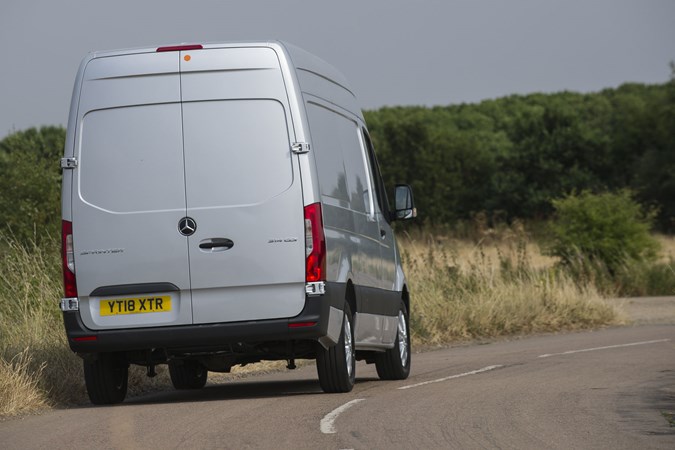
That said, as a collective, the entire Parkers team almost universally preferred the way the Crafter drove when testing the two back-to-back – with complaints about the Sprinter including the shortness of first gear (helpful for getting heavy loads moving), the (optional) electronic parking brake, and the need for constant steering correction, which quickly becomes tiring.
Engine power wasn’t raised as an issue, however, despite this particular Mercedes being 34hp down on this particular VW – the Sprinter is still easily powerful enough. No-one really made any comment about drive being directed at different axles, either, which just goes to show how well the engineers have sorted both competitors’ handling.
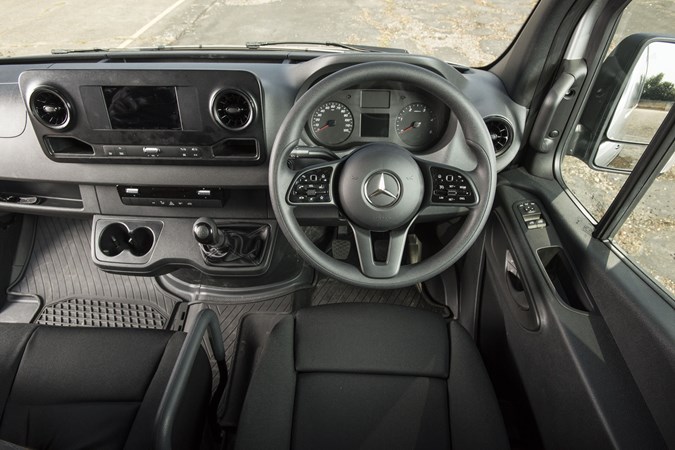
Yet the Sprinter’s steering certainly has a vague dead spot about the centre line, which does tend to mean you’re constantly juggling the wheel when travelling straight along the road.
Show it a few corners, though, and it’s as if this big van comes alive, feeling amazingly car-like and wieldy, and keen to get stuck in. You can really drive this thing – despite its size it changes direction eagerly and resists rolling around too much, while the suspension remains supple enough to soak up bumps without major concern.
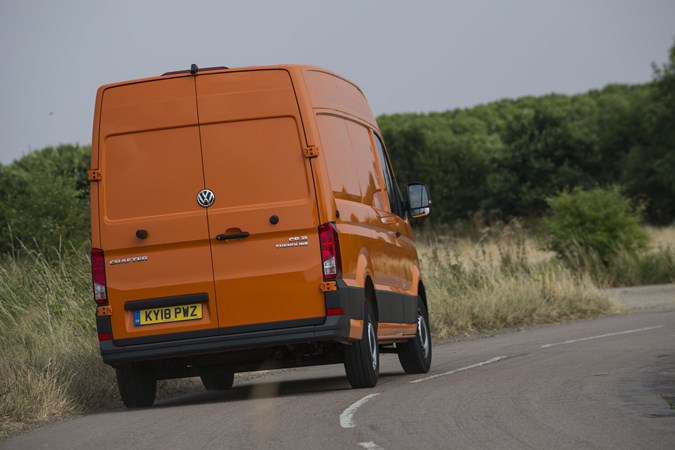
It’s quite an involving process and you can easily get carried away with your speed. But it’s also very interactive – which might explain why so many of the Parkers team liked the Crafter more. The VW deals with bumps even more smoothly and exudes a finessed stability that seems to take the rough edges off every journey while maintaining a high level of agility.
In fact, the Crafter boasts such immense easy-going competence it builds driver confidence super quickly. The steering is lighter than the Sprinter’s and the van is highly manoeuvrable, making mincemeat of tackling tight spaces in forward gears and reverse. Which reminds us: the gearbox action is slicker, too.
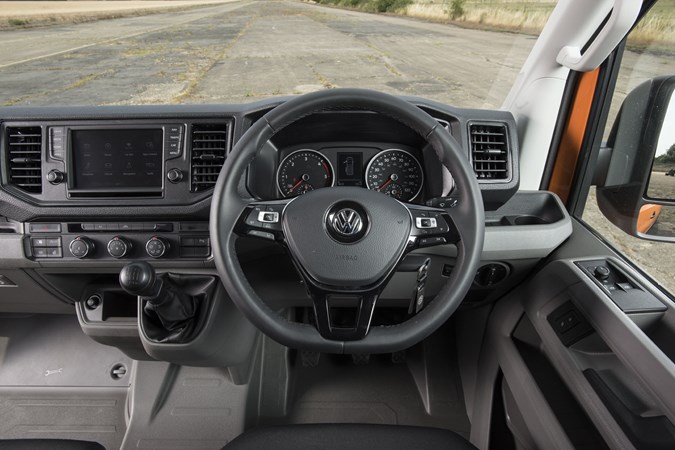
Ironically, VW’s cross-wind assistance system (both vans have the tech as standard) is so keen to keep you on course it can actually feel like the Crafter is moving around more than you would expect in blustery conditions, no doubt partly because it acts on the steering rather than just via the electronic stability control (ESC).
This takes a little getting used to but you will soon stop noticing it; still, Mercedes’ system is more subtle in its action and has no learning curve at all.
Regardless, both vans will shrug-off lengthy journeys, and both have good forward visibility. The Crafter has larger door mirrors, but we didn’t have any issues with the Mercedes’ rear view.
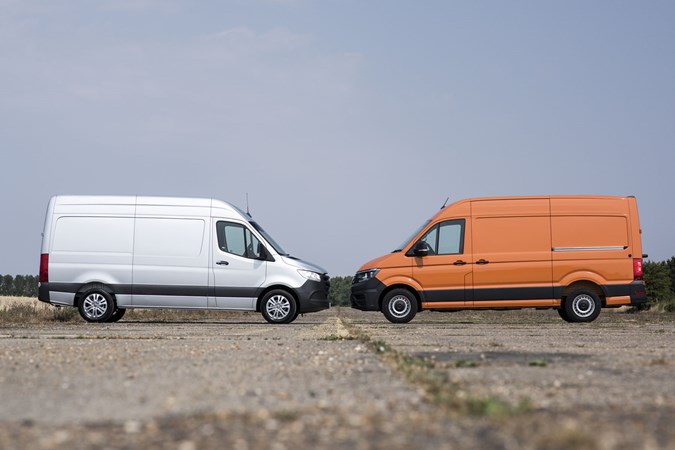
Blindspot monitors and lane-keeping assistance systems are available on both models if you want them – and these days you probably should.
You can also specify an automatic gearbox, rather than the six-speed manual transmissions fitted here. RWD Sprinters use an older, slightly clunky seven-speed item, but the brand new nine-speed option on FWD versions is great, as is the eight-speed auto available on all Crafter variants.
Mercedes Sprinter vs VW Crafter – load area and capacity comparison
The vans we have on test are matched for length and height, but rather than compare these two exact vans directly, here’s a more complete breakdown of how the Crafter and Sprinter compare across their entire ranges:
| Body length variant | Max load length (mm) | Wheelbase | |||
| Crafter | Sprinter | Crafter | Sprinter | Crafter | Sprinter |
| n/a | L1 | n/a | 2,607 | n/a | Short |
| Medium | L2 | 3,450 | 3,272 | Medium | Medium |
| Long | L3 | 4,300 | 4,307 | Long | Long |
| Long plus | L4 | 4,855 | 4,707 | Long | Long |
| Body height variant | Max load height (mm) | ||||
| Crafter | Sprinter | Crafter | Sprinter | ||
| Standard | H1 | 1,726 | 1,719 | ||
| High | H2 | 1,961 | TBC | ||
| Super-high | H3 | 2,196 | 2,234 | ||
| Maximum load width (mm) – all variants | |||||
| Crafter | Sprinter | ||||
| 1,832 | 1,787 | ||||
| Width between the wheelarches (mm) – all variants | |||||
| Crafter | Sprinter | ||||
| 1,380 | 1,350 | ||||
| Maximum load volume (cu m) – across entire range | |||||
| Crafter | Sprinter | ||||
| 9.9-18.4 | 7.8-17.0 | ||||
All these figures are for FWD variants; RWD Crafters lose 100mm of load height, RWD Sprinters lose 80mm.
As you can see from this, the Sprinter has an additional, shorter body size giving buyers the choice of four to the Crafter’s three, and an additional wheelbase length. But size-for-size, the two vans are generally within millimetres of each other.
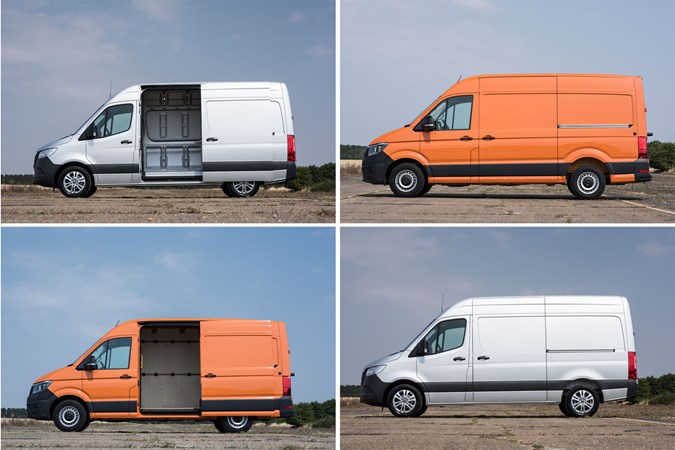
However, all versions of the VW are wider – including between the wheelarches – its side door has a wider opening, and it has the greater ultimate load volume, going up to 18.4 cubic metres of space to the Sprinter’s 17.0 cu m maximum.
Neither van offers outstanding payload at the maximum 3.5-tonne gross vehicle weight (GVW) you can drive on a regular car licence – rival manufacturers that are still selling much older designs of van with far less sophisticated technology have a distinct advantage here since their vehicles weigh less.
Take a look at our full list of the best 3.5t vans for payload for further details. Maximum at this GVW for the Crafter is 1,531kg (although that’s with some equipment deleted…) while for the Sprinter it’s 1,516kg; the figures are for FWD variants, which are the lightest in both cases.
Both Sprinter and Crafter come in 3.0-tonne and 5.0-tonne GVW variants as well, with the Sprinter also available as a 4.1-tonne GVW van.
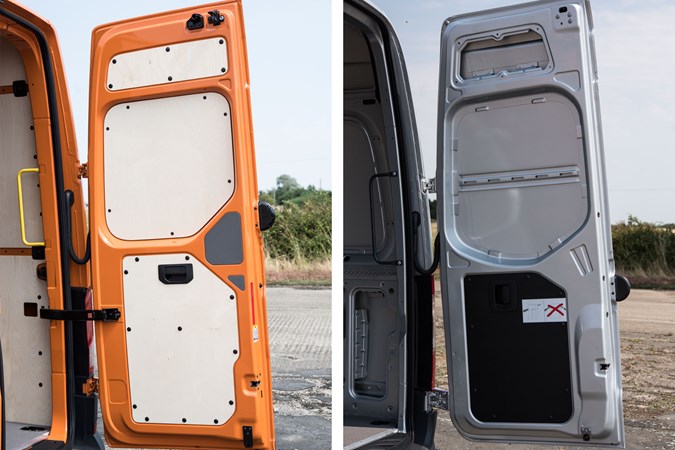
Mercedes and Volkswagen offer a wide range of high quality load area accessories, including lashing rails, various different flooring options, access steps and so forth.
Further notable points of difference between the two vans include a particularly trick set of rear door hinges on the Sprinter, which do without any kind of check mechanism, potentially saving precious seconds; the Crafter’s grab handles, meanwhile, seem stronger and more substantial.
VW Crafter vs Mercedes Sprinter – technology
The Crafter does very well for safety technology. In 2017, VW became the first manufacturer to make autonomous emergency braking (AEB) standard across its entire van range; depending on how much you want to spend on options, the Crafter is also able to steer itself for short periods of time, can be fitted with a crazily clever Trailer Assist system and a useful Side Protection system, plus much, much more.
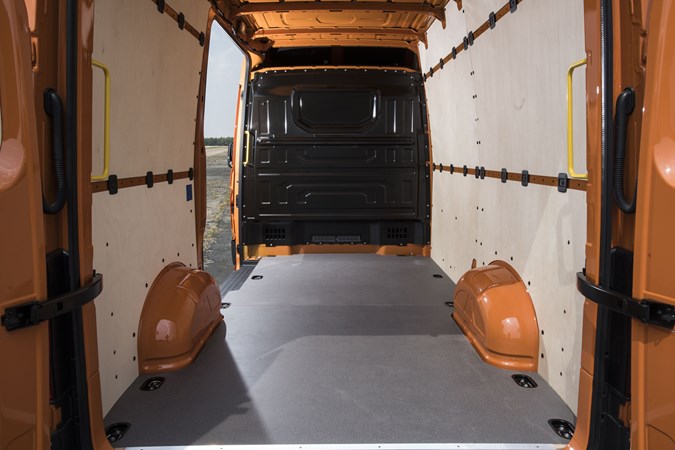
The Sprinter matches many of these features – though not the trailer assist and side protection functions – but also comes as standard with 4G internet connectivity and an infotainment system you can (almost) have a conversation with.
Simply say ‘Hey Mercedes’ and ask it to do something – and if that function is within the MBUX system’s parameters, the Sprinter will respond.
Once you’ve got an idea of what MBUX can do, it is very, very clever. Genuinely useful examples of its functions include giving you the ability to dictate text messages, set navigation destinations (where sat-nav is fitted – it’s not standard) and change radio stations, without pressing any buttons.
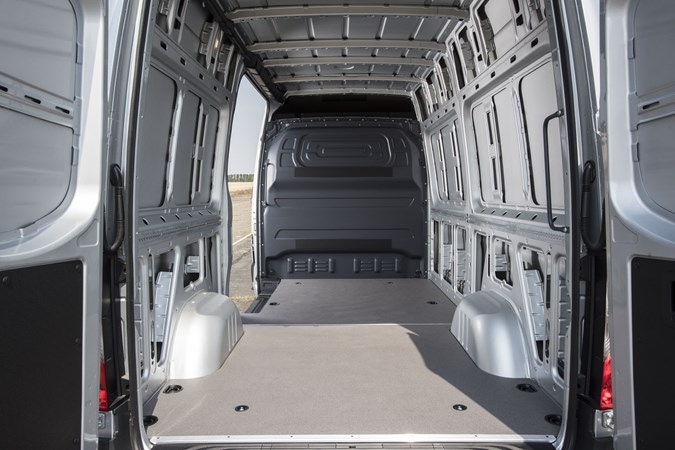
MBUX also adds a number of personalisation and connectivity features the VW just can’t match at this stage, including direct-to-van job instructions and sat-nav re-routing controlled by Mercedes’ own fleet management software, Mercedes Pro Connect.
As this hints, the included 4G modem means every Sprinter has built-in telematics capability as standard, which works with a suite of fleet management tools specially developed by Mercedes itself. It is, quite simply, the most connected van we’ve ever seen – and we suspect this will make it very popular with big fleets, as it will allow them to monitor van status and driver behaviour with ease, which promises improved efficiency.
VW is working on adding many of the same functions to the Crafter, but these aren’t here yet. So if you’re looking for the most high-tech van on the market right now, the Sprinter is most definitely it.
Mercedes Sprinter vs VW Crafter – value
Given the technology included, it’s no surprise Mercedes reckons the Sprinter has the most generous standard-equipment package in its class – which is hard to argue with. Beyond the MBUX system and 4G connectivity, highlights include keyless entry and start, Bluetooth, DAB radio and automatic headlights.
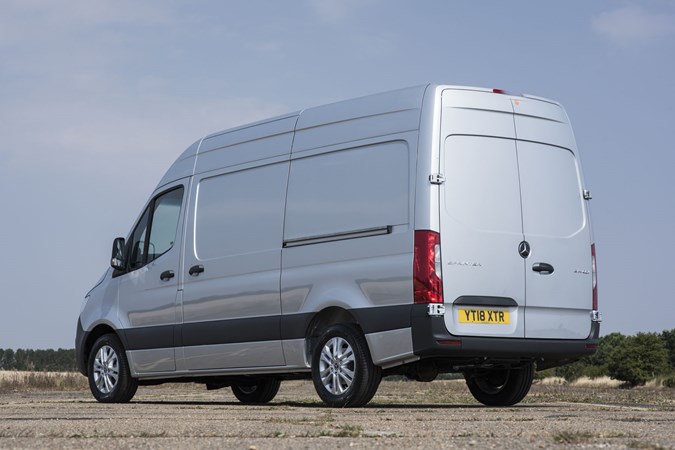
However, this generosity is also reflected in the list pricing, which is higher than any rival. At the time of writing, the difference between a Sprinter and an equivalent entry-level Crafter is around £1,700 (basic, excluding VAT); you’ll find the Mercedes closes the gap when it comes to equivalent leasing rates, mind.
>> Compare van insurance cost via mustard.co.uk
Typically for the Sprinter, there are no trim levels to choose from, just the basic spec and an extremely extensive options list. By contrast, VW sells the Crafter in three specifications – Startline, Trendline and Highline – which takes some of the pain out of deciding what you want to have fitted; plenty of options remain, though.
Either way, both models are right at the top of the large van sector when it comes to price, as you’d probably guessed. But as we’re constantly saying – that doesn’t mean they’re bad value. You get what you pay for and in this case you’ll be paying for a pair of excellent vans, each of which comes with a three-year unlimited mileage warranty.
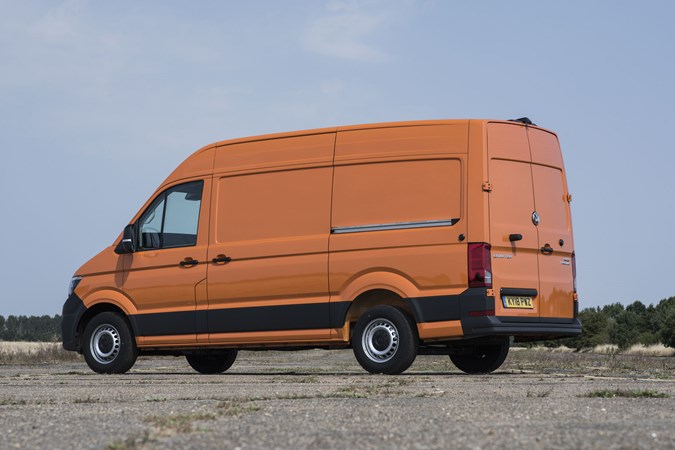
Only Mercedes offers 30 years of roadside assistance cover, known as MobiloVan. But both manufacturers offer service packages to help you spread maintenance costs.
Spec-for-spec, the VW has better claimed fuel consumption figures, though as with payload, this isn’t a particularly strong area for either van on paper – see our full comparison list for details. You should find their real world performance compares better with older rivals than this would suggest, however.
VW Crafter vs Mercedes Sprinter – which is better?
Ahead of writing this test, we were amused to discover these vans have the exact same overall star rating on their individual reviews – a decision taken on each model completely independently. This should tell you just how closely matched they really are.
The new Sprinter is, unquestionably, a masterpiece of advanced technology. If you need a van that’s right at the cutting edge of connectivity, this is the one for you. It’s also comfortable, good to drive and easy to use.
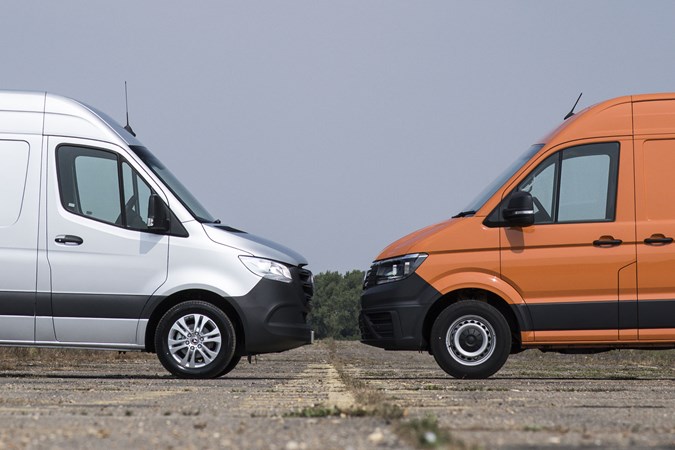
But technology aside, we find the Crafter edging just slightly ahead in every area. Out back, the load area is wider, the side door has a bigger opening and maximum capacity is higher, while up front it’s even more comfortable and even easier to drive – and the cab seems to have been designed with the end operator thoroughly in mind, rather than for eye-catching looks and high-tech bells and whistles.
Don’t get us wrong – we understand that there is a place for high-tech in modern vans, we appreciate every advanced safety feature and understand that the Sprinter is likely to make fleet management exceptionally straightforward. But as a van to drive and to operate as the person on the ground we’d choose the Crafter.
Which makes the VW our winner.
And finally… what about the MAN TGE?
While the Crafter and Sprinter are no longer the same van, the Volkswagen is also available in another guise as the MAN TGE. Badging and some specification details aside, the Crafter and the TGE are identical, which makes the TGE another very tempting option at the top end of the market – especially as it slots into MAN’s truck servicing network, which has round-the-clock coverage.
Well worth considering.
All photography by Stuart Collins
Also read:
>> Mercedes Sprinter (2018-on) full review
>> Volkswagen Crafter (2017-on) full review
>> Best large 3.5t vans for payload
>> Best large 3.5t vans for fuel economy
Just so you know, we may receive a commission or other compensation from the links on this website - read why you should trust us.


